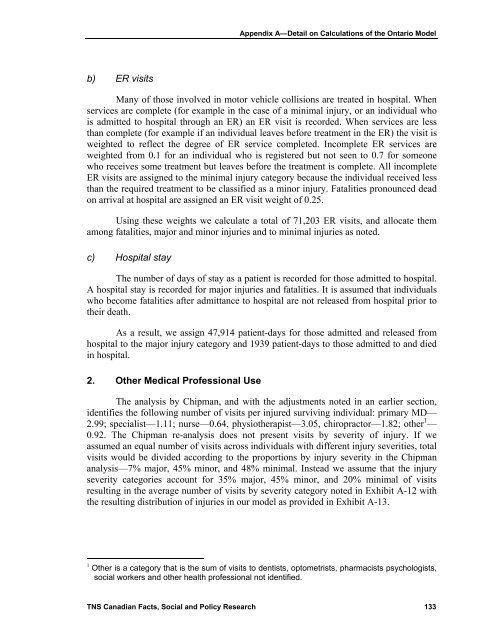Keith Vodden Dr. Douglas Smith - Transports Canada
Keith Vodden Dr. Douglas Smith - Transports Canada
Keith Vodden Dr. Douglas Smith - Transports Canada
Create successful ePaper yourself
Turn your PDF publications into a flip-book with our unique Google optimized e-Paper software.
Appendix A—Detail on Calculations of the Ontario Model<br />
b) ER visits<br />
Many of those involved in motor vehicle collisions are treated in hospital. When<br />
services are complete (for example in the case of a minimal injury, or an individual who<br />
is admitted to hospital through an ER) an ER visit is recorded. When services are less<br />
than complete (for example if an individual leaves before treatment in the ER) the visit is<br />
weighted to reflect the degree of ER service completed. Incomplete ER services are<br />
weighted from 0.1 for an individual who is registered but not seen to 0.7 for someone<br />
who receives some treatment but leaves before the treatment is complete. All incomplete<br />
ER visits are assigned to the minimal injury category because the individual received less<br />
than the required treatment to be classified as a minor injury. Fatalities pronounced dead<br />
on arrival at hospital are assigned an ER visit weight of 0.25.<br />
Using these weights we calculate a total of 71,203 ER visits, and allocate them<br />
among fatalities, major and minor injuries and to minimal injuries as noted.<br />
c) Hospital stay<br />
The number of days of stay as a patient is recorded for those admitted to hospital.<br />
A hospital stay is recorded for major injuries and fatalities. It is assumed that individuals<br />
who become fatalities after admittance to hospital are not released from hospital prior to<br />
their death.<br />
As a result, we assign 47,914 patient-days for those admitted and released from<br />
hospital to the major injury category and 1939 patient-days to those admitted to and died<br />
in hospital.<br />
2. Other Medical Professional Use<br />
The analysis by Chipman, and with the adjustments noted in an earlier section,<br />
identifies the following number of visits per injured surviving individual: primary MD—<br />
2.99; specialist—1.11; nurse—0.64, physiotherapist—3.05, chiropractor—1.82; other 1 —<br />
0.92. The Chipman re-analysis does not present visits by severity of injury. If we<br />
assumed an equal number of visits across individuals with different injury severities, total<br />
visits would be divided according to the proportions by injury severity in the Chipman<br />
analysis—7% major, 45% minor, and 48% minimal. Instead we assume that the injury<br />
severity categories account for 35% major, 45% minor, and 20% minimal of visits<br />
resulting in the average number of visits by severity category noted in Exhibit A-12 with<br />
the resulting distribution of injuries in our model as provided in Exhibit A-13.<br />
1 Other is a category that is the sum of visits to dentists, optometrists, pharmacists psychologists,<br />
social workers and other health professional not identified.<br />
TNS Canadian Facts, Social and Policy Research 133
















